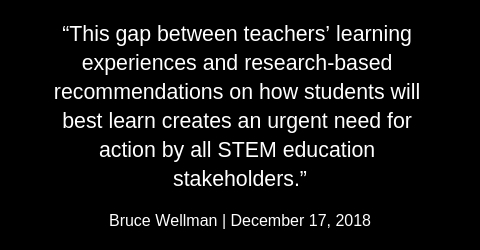Investigation and Design: Aligning Secondary Science to What is Best
By Kate Falk
Posted on 2018-12-17

Take a look at this short video from my high school chemistry class:
https://www.youtube.com/watch?v=sNHmVEJLAvI&feature=youtu.be
Now ask yourself, were you surprised by my choice to use ice to reboil the water? What did you feel when you watched that event? Were you curious about why that event could take place? Did you have your own unique questions you wanted answered?
If so, your experience is similar to the findings from the recent report from the National Academy of Sciences on what middle school and high school science students should experience when learning science and engineering. Students want to ask THEIR OWN questions AND solve real problems THEY SEE in their own communities.
As teachers, we know that Science is fundamentally based on asking questions about one’s surroundings and about seeking answers to questions that resonate with an individual scientist.
Investigation and design are the very activities that students need most in order to optimize science learning as well as to motivate them to explore and persist in STEM career pathways.
However, as the report points out, few middle and high school science teachers have truly experienced this type of investigation-based science themselves and have minimal to no experience from which to draw upon to design these types of learning experiences for students. Even fewer teachers have experience with authentic engineering design and problem solving.
This gap between teachers’ learning experiences and research-based recommendations on how students will best learn creates an urgent need for action by all STEM education stakeholders to:
1) Profoundly change how science teachers’ professional learning is funded, designed, delivered, and evaluated for effectiveness;
2) Innovatively create new models of STEM teacher roles (policy making, state and local curriculum development, and assessment design) to better utilize teachers with investigation and design experience without removing them completely from the classroom setting;
3) Strategically invest in the development of Open Education Resources by states (OER can be shared by ALL teachers throughout the country) that provide students with strong investigation and design experiences at the middle school and high school level.
Teachers need help to make this shift to investigation and design focused science learning. I like to use the analogy of teachers to surgeons. Who do you want operating on you? Do you want a practicing surgeon or someone who hasn’t been in an operating room for 10 years? Likewise, who is best positioned to train surgeons on new surgical techniques–a current surgeon or someone who hasn’t been in an operating room for 10 years?
Why would it be different for teachers? Teaching is a rapidly changing profession that requires multiple levels of simultaneous decision making analogous to the training and re-training demands found in surgical medicine. We need to create new infrastructures to capitalize on the expertise of excellent teachers without removing them completely from the teaching practice.
In addition, how many surgeons design their own surgical instruments or pharmaceutical tools to fulfill their job requirements? In contrast, most science teachers are forced to design their own tools (create learning sequences/curriculum, write or secure learning activities, identify new scientific findings that students should learn) as well as their own medicines (formative and summative assessment tools) all while learning about and servicing the individual needs and interests of over 100+ students on a daily basis.
Schools, districts and states must do better at providing the learning resources and assessment tools teachers need to create investigation and design-focused science classrooms for ALL middle and high school students in our country, regardless of zip code or ethnicity.
Our country’s security and global competitiveness depends upon us making this shift to ensure that ALL students learn science through investigations and design activities.
Editor’s Note: This presentation was part of a Senate briefing on the National Academy of Sciences report Science and Engineering for Grades 6-12: Investigation and Design at the Center hosted by NSTA and the STEM Education Coalition; details on that event here.
Bruce Wellman currently teaches high school students chemistry and engineering design at the Olathe Public Schools’ Engineering Academy at Olathe Northwest High School in Olathe, Kansas. He is a Nationally Board Certified Teacher (Adolescent and Young Adulthood Science, Chemistry) since 2006, a 2009 Presidential Awardee for Excellence in Math & Science Teaching (PAEMST), and is active on several professional organization committees: the American Society for Engineering Education Board of Directors’ Committee on P12 Engineering Education and various committees at the National Academy of Sciences and the National Academy of Engineering. He served as a reviewer for the NAS report Science and Engineering for Grades 6-12: Investigation and Design at the Center.
Disclaimer: The views expressed in this blog post are those of the author(s) and do not necessarily reflect the official position of the National Science Teaching Association (NSTA).

